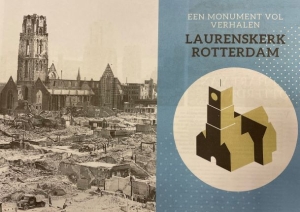Visit
The Laurenskerk “Get to know history, create the future”
The centre of Rotterdam was almost completely wiped out during the bombing on 14 May, 1940. Of the Laurenskerk, only the walls and tower remained standing. People soon rolled up their sleeves and got to work clearing the rubble and building a new city. Only the medieval Laurenskerk was restored, which is seen as a symbol of the resilience of the people of Rotterdam and also represents its reconstruction.
Towerclimb
The towerclimbs will start again in March 2024
The Laurenskerk tower is open to visitors from Tuesday to Saturday from March till October.
Towerclimbs are possible on Wednesday (14:00 hrs) and Saturday (12:00 and 13:30 hrs) with a tourguide.
Our knowledgable guide can inform you about the story of the tower, when climbing to the top you will pass the carillon of the Hemon company from the 17th century and the associated giant drum on your way. After climbing more than 300 steps, a spectacular view of the Rotterdam skyline awaits you on the roof.
Visting the tower is €7,50 per person or free with a Rotterdam pass.
The minimum age is 6 years. Tickets can be purchased at the Laurenskerk box office on the day of your visit, between 10:00 til 16:30 hrs.
Note: Opening times may change due to private meetings or special occasions, please check our opening times.
In April/May/June/September/October climbing is possible on
Wednesday 14:00 hours
Saturday: 12:00 and 13:30 hours
Please check our website for actual opening times.
Its not possible to reserve a ticket.
You can buy a ticket before the start of every towerclimb at the desk in the Laurenskerk.
Openings times & prices
Opening hours
Tickets can be purchased at the registerdesk in the church.
March till October
Tuesday to Saturday from 10:00 till 17:00 hours.
November till February
Tuesday to Saturday from 11:00 till 17:00 hours
Sunday: only open for church services.
Attention! Opening times may change due to private meetings or special occasions.
August
Saturday 17 August -CLOSED after 14.00 p.m.
Friday 23 August -CLOSED
Tuesday 27 August -CLOSED
September
Saturday 7 September -CLOSED
Tuesday 10 September -CLOSED
Thursday 12 September -CLOSED
Friday 13 September -CLOSED
Tuesday 17 September -CLOSED
Wednesday 18 September -CLOSED
Thursday 19 September -CLOSED
Friday 20 September -CLOSED
Saturday 21 September -CLOSED
Tuesday 24 September -CLOSED
Friday 27 September -CLOSED
Saturday 28 September -CLOSED
Tarieven
| Prijs | ||
|---|---|---|
| Visit church | Adult/Youth | € 4,00 |
| Children up to 12 years | free | |
| Towerclimb | Adult | € 7,50 |
| Children up to 12 years | € 4,50 | |
| R’dampas | 1x free | |
| Group discount (15 person) | Adult | 25% discount |
Storybook
To share the unique story of the Laurenskerk and the city, a museal design was implemented in 2010 under the title De Laurenskerk, a monument full of stories. Using theexhibition newspaper, visitors can discover the history of the Laurenskerk in 84 diverse stories. You can learn, for example, where the late Queen Juliana masoned the first stone at the beginning of the reconstruction, or which spiritual festivals are celebrated by the various demographics populating Rotterdam. Visitors can also watch a compelling film about the bombings of Rotterdam, Coventry, and Dresden

Virtual sightseeing
(made by Ramon Mendeville van Aspex Media.)
Attractions
Italian artist Giacomo Manzù designed the bronze doors of war and peace in the 1960s. The door’s panels depict the horrors of war and the joys of peace. Also worth seeing are the 18th-century brass choir screen, the baptismal font of Hans Petri from the 1960s, the 17th-century tombs of Witte de With, Egbert Kortenaer, and Johan van Brakel, and three Marcussen organs – including the largest organ in the Netherlands.
History
The Grote Laurenskerk, or Sint Laurenskerk, colloquially known as simply the Laurenskerk or Laurens, has traditionally served as Rotterdam’s “main church”. Built between 1449 and 1525, the church is the only remaining late Gothic building in Rotterdam, which was originally medieval.
For many, the Laurenskerk is a symbol of Rotterdam’s history. For example, in the Middle Ages, citizenship of Rotterdam could be purchased by contributing 3000 stones to the construction of the church tower. Images of the badly-damaged building during World War II and its reconstruction afterwards grew to represent the good fortune of the city and its residents.


